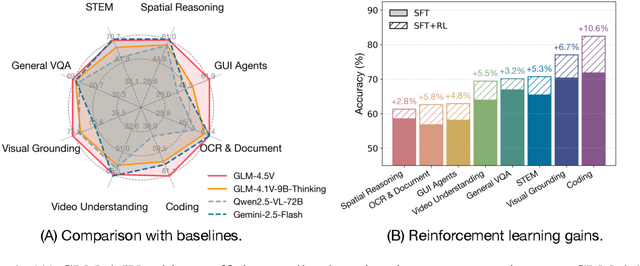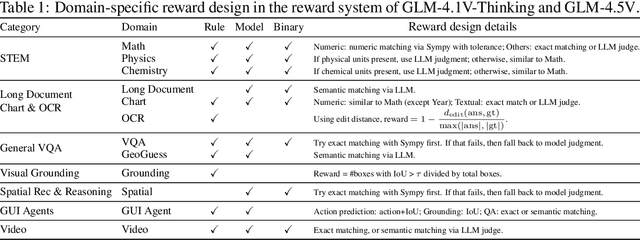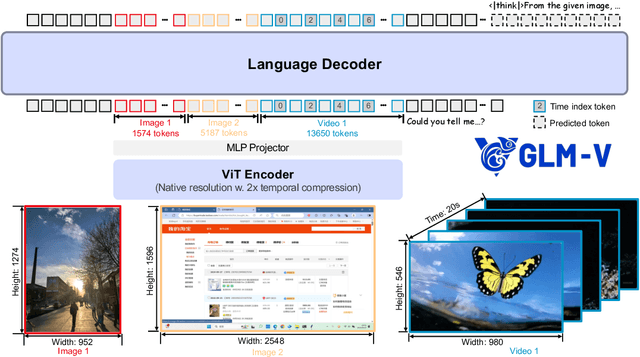Yuxuan Zhang
A Rigorous Benchmark with Multidimensional Evaluation for Deep Research Agents: From Answers to Reports
Oct 02, 2025Abstract:Artificial intelligence is undergoing the paradigm shift from closed language models to interconnected agent systems capable of external perception and information integration. As a representative embodiment, Deep Research Agents (DRAs) systematically exhibit the capabilities for task decomposition, cross-source retrieval, multi-stage reasoning, and structured output, which markedly enhance performance on complex and open-ended tasks. However, existing benchmarks remain deficient in evaluation dimensions, response formatting, and scoring mechanisms, limiting their capacity to assess such systems effectively. This paper introduces a rigorous benchmark and a multidimensional evaluation framework tailored to DRAs and report-style responses. The benchmark comprises 214 expert-curated challenging queries distributed across 10 broad thematic domains, each accompanied by manually constructed reference bundles to support composite evaluation. The framework enables comprehensive evaluation of long-form reports generated by DRAs, incorporating integrated scoring metrics for semantic quality, topical focus, and retrieval trustworthiness. Extensive experimentation confirms the superior performance of mainstream DRAs over web-search-tool-augmented reasoning models, yet reveals considerable scope for further improvement. This study provides a robust foundation for capability assessment, architectural refinement, and paradigm advancement in DRA systems.
LENS: Learning to Segment Anything with Unified Reinforced Reasoning
Aug 19, 2025Abstract:Text-prompted image segmentation enables fine-grained visual understanding and is critical for applications such as human-computer interaction and robotics. However, existing supervised fine-tuning methods typically ignore explicit chain-of-thought (CoT) reasoning at test time, which limits their ability to generalize to unseen prompts and domains. To address this issue, we introduce LENS, a scalable reinforcement-learning framework that jointly optimizes the reasoning process and segmentation in an end-to-end manner. We propose unified reinforcement-learning rewards that span sentence-, box-, and segment-level cues, encouraging the model to generate informative CoT rationales while refining mask quality. Using a publicly available 3-billion-parameter vision-language model, i.e., Qwen2.5-VL-3B-Instruct, LENS achieves an average cIoU of 81.2% on the RefCOCO, RefCOCO+, and RefCOCOg benchmarks, outperforming the strong fine-tuned method, i.e., GLaMM, by up to 5.6%. These results demonstrate that RL-driven CoT reasoning serves as a robust prior for text-prompted segmentation and offers a practical path toward more generalizable Segment Anything models. Code is available at https://github.com/hustvl/LENS.
GLM-4.5: Agentic, Reasoning, and Coding (ARC) Foundation Models
Aug 08, 2025Abstract:We present GLM-4.5, an open-source Mixture-of-Experts (MoE) large language model with 355B total parameters and 32B activated parameters, featuring a hybrid reasoning method that supports both thinking and direct response modes. Through multi-stage training on 23T tokens and comprehensive post-training with expert model iteration and reinforcement learning, GLM-4.5 achieves strong performance across agentic, reasoning, and coding (ARC) tasks, scoring 70.1% on TAU-Bench, 91.0% on AIME 24, and 64.2% on SWE-bench Verified. With much fewer parameters than several competitors, GLM-4.5 ranks 3rd overall among all evaluated models and 2nd on agentic benchmarks. We release both GLM-4.5 (355B parameters) and a compact version, GLM-4.5-Air (106B parameters), to advance research in reasoning and agentic AI systems. Code, models, and more information are available at https://github.com/zai-org/GLM-4.5.
Protenix-Mini: Efficient Structure Predictor via Compact Architecture, Few-Step Diffusion and Switchable pLM
Jul 16, 2025



Abstract:Lightweight inference is critical for biomolecular structure prediction and other downstream tasks, enabling efficient real-world deployment and inference-time scaling for large-scale applications. In this work, we address the challenge of balancing model efficiency and prediction accuracy by making several key modifications, 1) Multi-step AF3 sampler is replaced by a few-step ODE sampler, significantly reducing computational overhead for the diffusion module part during inference; 2) In the open-source Protenix framework, a subset of pairformer or diffusion transformer blocks doesn't make contributions to the final structure prediction, presenting opportunities for architectural pruning and lightweight redesign; 3) A model incorporating an ESM module is trained to substitute the conventional MSA module, reducing MSA preprocessing time. Building on these key insights, we present Protenix-Mini, a compact and optimized model designed for efficient protein structure prediction. This streamlined version incorporates a more efficient architectural design with a two-step Ordinary Differential Equation (ODE) sampling strategy. By eliminating redundant Transformer components and refining the sampling process, Protenix-Mini significantly reduces model complexity with slight accuracy drop. Evaluations on benchmark datasets demonstrate that it achieves high-fidelity predictions, with only a negligible 1 to 5 percent decrease in performance on benchmark datasets compared to its full-scale counterpart. This makes Protenix-Mini an ideal choice for applications where computational resources are limited but accurate structure prediction remains crucial.
General Modular Harness for LLM Agents in Multi-Turn Gaming Environments
Jul 15, 2025Abstract:We introduce a modular harness design for LLM agents that composes of perception, memory, and reasoning components, enabling a single LLM or VLM backbone to tackle a wide spectrum of multi turn gaming environments without domain-specific engineering. Using classic and modern game suites as low-barrier, high-diversity testbeds, our framework provides a unified workflow for analyzing how each module affects performance across dynamic interactive settings. Extensive experiments demonstrate that the harness lifts gameplay performance consistently over un-harnessed baselines and reveals distinct contribution patterns, for example, memory dominates in long-horizon puzzles while perception is critical in vision noisy arcades. These findings highlight the effectiveness of our modular harness design in advancing general-purpose agent, given the familiarity and ubiquity of games in everyday human experience.
Stable-Hair v2: Real-World Hair Transfer via Multiple-View Diffusion Model
Jul 10, 2025



Abstract:While diffusion-based methods have shown impressive capabilities in capturing diverse and complex hairstyles, their ability to generate consistent and high-quality multi-view outputs -- crucial for real-world applications such as digital humans and virtual avatars -- remains underexplored. In this paper, we propose Stable-Hair v2, a novel diffusion-based multi-view hair transfer framework. To the best of our knowledge, this is the first work to leverage multi-view diffusion models for robust, high-fidelity, and view-consistent hair transfer across multiple perspectives. We introduce a comprehensive multi-view training data generation pipeline comprising a diffusion-based Bald Converter, a data-augment inpainting model, and a face-finetuned multi-view diffusion model to generate high-quality triplet data, including bald images, reference hairstyles, and view-aligned source-bald pairs. Our multi-view hair transfer model integrates polar-azimuth embeddings for pose conditioning and temporal attention layers to ensure smooth transitions between views. To optimize this model, we design a novel multi-stage training strategy consisting of pose-controllable latent IdentityNet training, hair extractor training, and temporal attention training. Extensive experiments demonstrate that our method accurately transfers detailed and realistic hairstyles to source subjects while achieving seamless and consistent results across views, significantly outperforming existing methods and establishing a new benchmark in multi-view hair transfer. Code is publicly available at https://github.com/sunkymepro/StableHairV2.
GLM-4.1V-Thinking: Towards Versatile Multimodal Reasoning with Scalable Reinforcement Learning
Jul 02, 2025



Abstract:We present GLM-4.1V-Thinking, a vision-language model (VLM) designed to advance general-purpose multimodal understanding and reasoning. In this report, we share our key findings in the development of the reasoning-centric training framework. We first develop a capable vision foundation model with significant potential through large-scale pre-training, which arguably sets the upper bound for the final performance. We then propose Reinforcement Learning with Curriculum Sampling (RLCS) to unlock the full potential of the model, leading to comprehensive capability enhancement across a diverse range of tasks, including STEM problem solving, video understanding, content recognition, coding, grounding, GUI-based agents, and long document understanding. We open-source GLM-4.1V-9B-Thinking, which achieves state-of-the-art performance among models of comparable size. In a comprehensive evaluation across 28 public benchmarks, our model outperforms Qwen2.5-VL-7B on nearly all tasks and achieves comparable or even superior performance on 18 benchmarks relative to the significantly larger Qwen2.5-VL-72B. Notably, GLM-4.1V-9B-Thinking also demonstrates competitive or superior performance compared to closed-source models such as GPT-4o on challenging tasks including long document understanding and STEM reasoning, further underscoring its strong capabilities. Code, models and more information are released at https://github.com/THUDM/GLM-4.1V-Thinking.
Enhancing Vector Quantization with Distributional Matching: A Theoretical and Empirical Study
Jun 18, 2025Abstract:The success of autoregressive models largely depends on the effectiveness of vector quantization, a technique that discretizes continuous features by mapping them to the nearest code vectors within a learnable codebook. Two critical issues in existing vector quantization methods are training instability and codebook collapse. Training instability arises from the gradient discrepancy introduced by the straight-through estimator, especially in the presence of significant quantization errors, while codebook collapse occurs when only a small subset of code vectors are utilized during training. A closer examination of these issues reveals that they are primarily driven by a mismatch between the distributions of the features and code vectors, leading to unrepresentative code vectors and significant data information loss during compression. To address this, we employ the Wasserstein distance to align these two distributions, achieving near 100\% codebook utilization and significantly reducing the quantization error. Both empirical and theoretical analyses validate the effectiveness of the proposed approach.
WikiGap: Promoting Epistemic Equity by Surfacing Knowledge Gaps Between English Wikipedia and other Language Editions
May 30, 2025Abstract:With more than 11 times as many pageviews as the next, English Wikipedia dominates global knowledge access relative to other language editions. Readers are prone to assuming English Wikipedia as a superset of all language editions, leading many to prefer it even when their primary language is not English. Other language editions, however, comprise complementary facts rooted in their respective cultures and media environments, which are marginalized in English Wikipedia. While Wikipedia's user interface enables switching between language editions through its Interlanguage Link (ILL) system, it does not reveal to readers that other language editions contain valuable, complementary information. We present WikiGap, a system that surfaces complementary facts sourced from other Wikipedias within the English Wikipedia interface. Specifically, by combining a recent multilingual information-gap discovery method with a user-centered design, WikiGap enables access to complementary information from French, Russian, and Chinese Wikipedia. In a mixed-methods study (n=21), WikiGap significantly improved fact-finding accuracy, reduced task time, and received a 32-point higher usability score relative to Wikipedia's current ILL-based navigation system. Participants reported increased awareness of the availability of complementary information in non-English editions and reconsidered the completeness of English Wikipedia. WikiGap thus paves the way for improved epistemic equity across language editions.
EasyText: Controllable Diffusion Transformer for Multilingual Text Rendering
May 30, 2025Abstract:Generating accurate multilingual text with diffusion models has long been desired but remains challenging. Recent methods have made progress in rendering text in a single language, but rendering arbitrary languages is still an unexplored area. This paper introduces EasyText, a text rendering framework based on DiT (Diffusion Transformer), which connects denoising latents with multilingual character tokens encoded as character tokens. We propose character positioning encoding and position encoding interpolation techniques to achieve controllable and precise text rendering. Additionally, we construct a large-scale synthetic text image dataset with 1 million multilingual image-text annotations as well as a high-quality dataset of 20K annotated images, which are used for pretraining and fine-tuning respectively. Extensive experiments and evaluations demonstrate the effectiveness and advancement of our approach in multilingual text rendering, visual quality, and layout-aware text integration.
 Add to Chrome
Add to Chrome Add to Firefox
Add to Firefox Add to Edge
Add to Edge